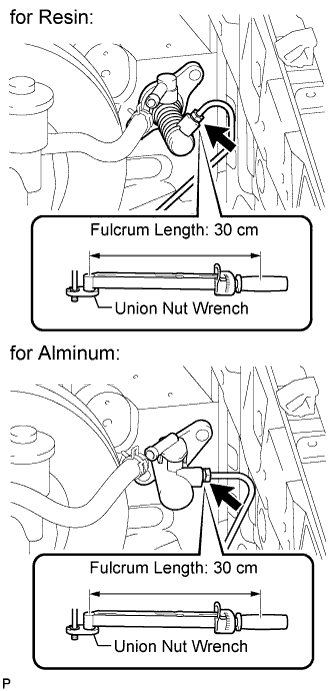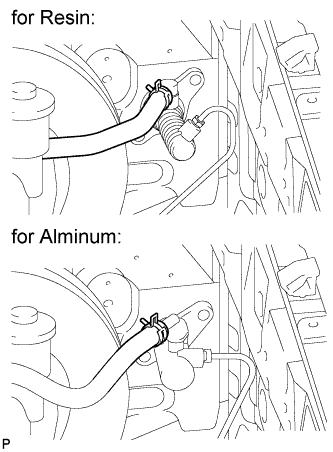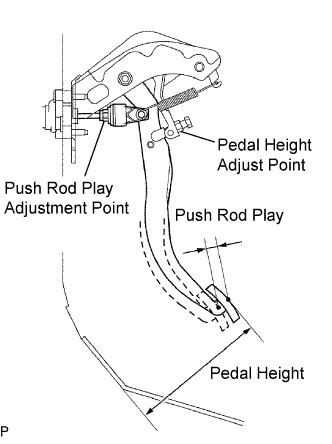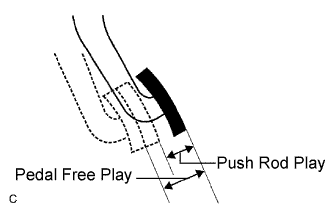Clutch Master Cylinder -- Installation |
| 1. INSTALL CYLINDER PUSH ROD CLEVIS |
Install the lock nut and clevis to the push rod.
- HINT:
- Tighten the lock nut to the specified torque when adjusting the clutch pedal.
| 2. INSTALL CLUTCH MASTER CYLINDER ASSEMBLY |
Install a new gasket and the clutch master cylinder assembly with the 2 nuts.
- Torque:
- 14 N*m{145 kgf*cm, 10 ft.*lbf}
for LHD:
Install the clutch pedal (Toyota Fortuner RM0000010R2007X.html).
for RHD:
Install the clutch pedal (Toyota Fortuner RM0000010R200MX.html).
| 3. CONNECT CLUTCH MASTER CYLINDER TO FLEXIBLE HOSE TUBE |
 |
Using a union nut wrench, connect the tube.
- Torque:
- without union nut wrench:
- 15 N*m{155 kgf*cm, 11 ft.*lbf}
- with union nut wrench:
- 14 N*m{143 kgf*cm, 10 ft.*lbf}
- HINT:
- Use a torque wrench with a fulcrum length of 30 cm (11.81 in.).
- The torque value for use with a union nut wrench is effective when the union nut wrench is parallel to the torque wrench.
| 4. CONNECT CLUTCH RESERVOIR HOSE |
 |
Connect the clutch reservoir hose with the clip to the clutch master cylinder.
- NOTICE:
- Connect the clutch reservoir hose so that it is not twisted.
| 5. INSTALL COMBINATION METER ASSEMBLY |
Install the combination meter assembly (Toyota Fortuner RM000000THQ008X.html).
| 6. INSTALL LOWER INSTRUMENT PANEL FINISH PANEL SUB-ASSEMBLY |
 |
Attach the 2 claws and 3 clips to install the panel.
| 7. BLEED AIR FROM CLUTCH PIPE LINE |
Fill the master cylinder reservoir with fluid.
Bleed air from the clutch system (Toyota Fortuner RM0000010R7004X.html).
| 8. CHECK FOR CLUTCH FLUID LEAKAGE |
| 9. INSPECT AND ADJUST CLUTCH PEDAL ASSEMBLY |
Lift up the floor carpet to expose the asphalt sheet under the pedal.
Check that the pedal height is correct.
- Pedal height from dash panel:
- 179.6 to 189.6 mm (7.070 to 7.464 in.)
 |
Adjust the pedal height.
Loosen the lock nut and turn the stopper bolt until the pedal height is within the specified range.
Tighten the lock nut.
- Torque:
- 25 N*m{25 kgf*cm, 18 ft.*lbf}
Check the pedal free play and push rod play.
Depress the clutch pedal until resistance is felt.
Measure the distance between the pedal's released position and the position in the previous step.
- Pedal free play:
- 5.0 to 15.0 mm (0.197 to 0.591 in.)
Release the pedal. Using your finger, gently press the pedal until resistance increases slightly.
Measure the distance between the pedal's released position and the position in the previous step.
- Push rod play at pedal top:
- 1.0 to 5.0 mm (0.039 to 0.197 in.)
 |
Adjust the pedal free play and push rod play.
Loosen the lock nut and turn the push rod until the pedal free play and push rod play are within the specified ranges.
Tighten the lock nut.
- Torque:
- 12 N*m{122 kgf*cm, 9 ft.*lbf}
After adjusting the pedal free play, check the pedal height.
Check the clutch release point.
Pull the parking brake lever and use wheel chocks to stabilize the vehicle.
Start the engine and run it at idle.
Without depressing the clutch pedal, slowly move the shift lever to R until the gears contact.
Gently depress the clutch pedal and measure the stroke distance from the point that the gear noise stops (release point) up to the full stroke end position.
- Standard distance:
- 25 mm (0.984 in.) or more
- Check pedal height.
- Check push rod play and pedal free play.
- Bleed air from clutch line.
- Check clutch cover and disc.
 |
| 10. CHECK FLUID LEVEL IN RESERVOIR |
- Fluid:
- SAE J1703 or FMVSS No. 116 DOT3